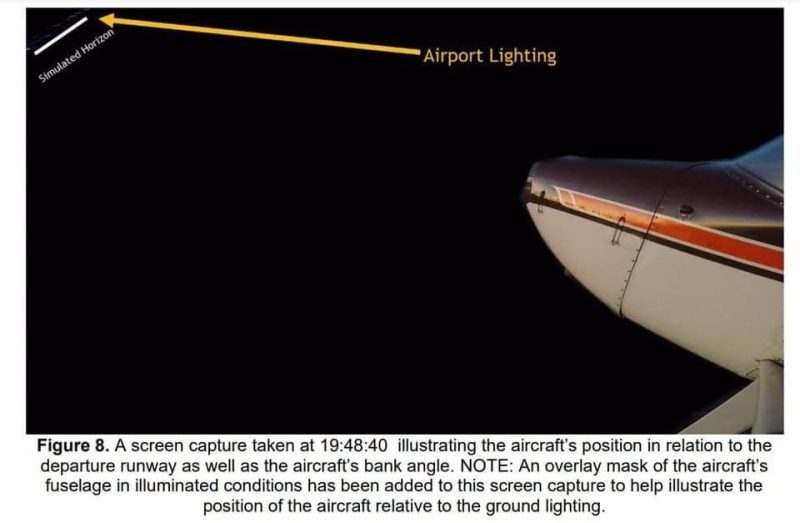On April 15, 2021, at about 1948 mountain standard time, a Cessna 140A, N2506N, was substantially damaged when it was involved in an accident near Williams, Arizona. The commercial pilot and passenger were fatally injured. The airplane was operated as a Title 14 Code of Federal Regulations Part 91 personal flight.
During a night cross-country flight in visual meteorological conditions, the pilot made a precautionary landing due to a failure of the airplane’s engine tachometer. The audio from an airframe-mounted camera captured the pilot’s post-flight inspection comment that the tachometer cable housing appeared to be intact and subsequent departure on the accident flight. Shortly after takeoff, the pilot deviated left of the runway heading before entering a right turn, away from an on-course heading toward the destination airport. The departure airport was located in a sparsely populated valley with rising terrain on all sides. The airport’s chart supplement indicated that a 479-foot hill existed about 1.4 nautical miles north of the departure end of the runway.

Sound spectrum analysis of the video revealed that the engine RPM decreased slightly, and the video showed an increase in the airplane’s bank angle. There was no indication on the camera of any distress or malfunction. The increased bank angle of the airplane, along with the airplane’s descent and impact with terrain, was consistent with an incipient loss of control.
Examination of the airframe and engine revealed no evidence of additional mechanical failure or malfunction that would have precluded normal operation. A review of the pilot’s logbook indicated 10.1 hours of night experience and that his most recent night flight before the accident flight was over 90 days before the accident. The lack of cultural lighting in the vicinity of the airport would have provided few visual cues to help the pilot maintain attitude orientation. In addition, the pilot’s decision to fly the airplane without a functioning tachometer may have served as an operational distraction after takeoff. Given the lack of mechanical anomalies, the departure into impoverished lighting conditions, the pilot’s lack of recent night flight experience, and the descending turn into terrain, the circumstances of the accident are consistent with a loss of control shortly after takeoff as a result of the pilot’s spatial disorientation.
- Probable Cause: The pilot’s loss of control due to spatial disorientation in visual meteorological conditions shortly after takeoff at night.
- Preventing Similar Accidents:
Reduced Visual References Require Vigilance - About two-thirds of general aviation accidents that occur in reduced visibility weather conditions are fatal. The accidents can involve pilot spatial disorientation or controlled flight into terrain. Even in visual weather conditions, flights at night over areas with limited ground lighting (which provides few visual ground references) can be challenging.
Preflight weather briefings are critical to safe flight. In-flight, weather information can also help pilots make decisions, as can in-cockpit weather equipment that can supplement official information. In-cockpit equipment requires an understanding of its features and limitations.
We often see pilots who decide to turn back after they have already encountered weather; that is too late. Pilots shouldn’t allow a situation to become dangerous before deciding to act. Additionally, air traffic controllers are there to help; be honest with them about your situation and ask for help.
Even when flying at night, visual weather conditions can also be challenging. Remote areas with limited ground lighting provide limited visual reference cues for pilots, which can be disorienting or render rising terrain visually imperceptible. Topographic references can help pilots become more familiar with the terrain. The use of instruments, if pilots are proficient, can also help pilots navigate these challenging areas.
See NTSB Safety Alert SA_020 for additional resources. The NTSB presents this information to prevent the recurrence of similar accidents. Note that this should not be considered guidance from the regulator, nor does this supersede existing FAA Regulations. Source: ‚Aviation Accidents / NTSB‚.


